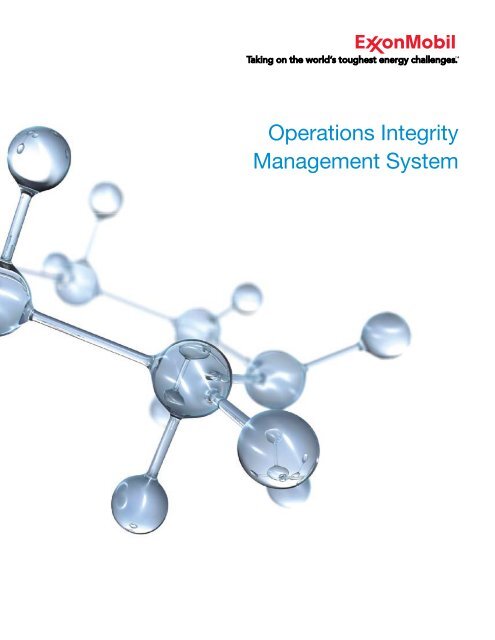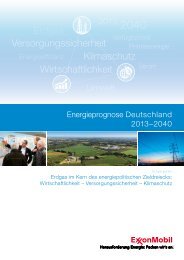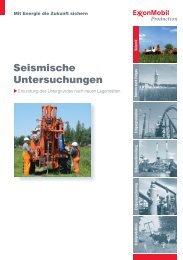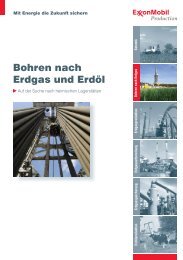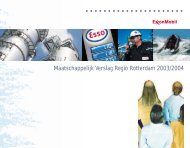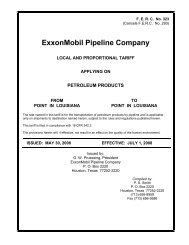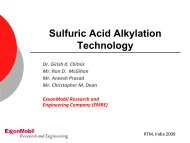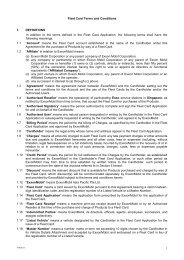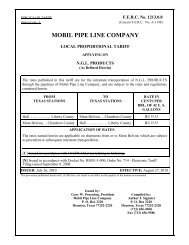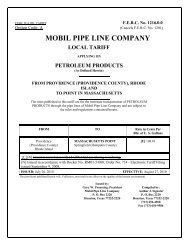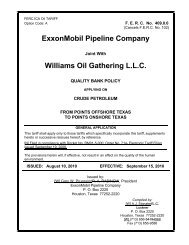Operations Integrity Management System (OIMS) - ExxonMobil
Operations Integrity Management System (OIMS) - ExxonMobil
Operations Integrity Management System (OIMS) - ExxonMobil
Create successful ePaper yourself
Turn your PDF publications into a flip-book with our unique Google optimized e-Paper software.
<strong>Operations</strong> <strong>Integrity</strong><br />
<strong>Management</strong> <strong>System</strong>
<strong>ExxonMobil</strong> remains steadfast in its commitment to<br />
excellence in Safety, Security, Health and Environmental<br />
(SSH&E) performance, referred to collectively as<br />
<strong>Operations</strong> <strong>Integrity</strong>. Many of our operations and<br />
products present potential risks to people and to the<br />
environment. Recognizing these risks is inherent in<br />
our business, and we believe the best way to meet<br />
our commitment is through a capable, committed<br />
workforce, and practices designed to enable safe,<br />
secure and environmentally responsible operations. We<br />
accomplish this through clearly defined policies and<br />
practices, and with rigorously applied management<br />
systems designed to deliver results.<br />
The <strong>Operations</strong> <strong>Integrity</strong> <strong>Management</strong> <strong>System</strong> (<strong>OIMS</strong>)<br />
is a cornerstone of our commitment to managing<br />
SSH&E risk and achieving excellence in performance.<br />
Since the inception of <strong>OIMS</strong>, our SSH&E performance<br />
has improved substantially. Industry-leading lost-time<br />
incident rates have been significantly reduced. Risks to<br />
the environment have been reduced, with a remarkable<br />
decline in marine spills and continuing reductions in<br />
emissions. We have been cited by Lloyd’s Register<br />
Quality Assurance for “being among the leaders<br />
in the extent to which environmental management<br />
considerations have been integrated into our ongoing<br />
business practices.”<br />
All operating organizations are required to maintain<br />
the systems and practices needed to conform to the<br />
Expectations described in the <strong>OIMS</strong> Framework.<br />
To drive continuous improvement, the Framework<br />
is periodically updated. This revision strengthens<br />
Framework Expectations with respect to leadership,<br />
process safety, environmental performance, and the<br />
assessment of <strong>OIMS</strong> effectiveness and is intended to:<br />
• reinforce our belief that all safety, health and<br />
environmental incidents are preventable; and to<br />
• promote and maintain a work environment in<br />
which each of us accepts personal responsibility<br />
for our own safety and that of our colleagues, and<br />
in which everyone actively intervenes to ensure<br />
the safety, security and wellness of others.<br />
OPERATIONS INTEGRITY MANAGEMENT SYSTEM: chairman’s message<br />
We believe these measures will help drive <strong>ExxonMobil</strong><br />
closer to our vision of a workplace where “Nobody<br />
Gets Hurt,” where “Security is Everybody’s Business,”<br />
and where our environmental performance meets our<br />
expectations to “Protect Tomorrow. Today.”<br />
Rex W. Tillerson<br />
Chairman & Chief Executive Officer<br />
3
4 OPERATIONS INTEGRITY MANAGEMENT SYSTEM: the framework<br />
<strong>ExxonMobil</strong> is committed to conducting business in<br />
a manner that is compatible with the environmental<br />
and economic needs of the communities in which<br />
we operate, and that protects the safety, security,<br />
and health of our employees, those involved with our<br />
operations, our customers, and the public. These<br />
commitments are documented in our Safety, Security,<br />
Health, Environmental, and Product Safety policies.<br />
These policies are put into practice through a disciplined<br />
management framework called the <strong>Operations</strong> <strong>Integrity</strong><br />
<strong>Management</strong> <strong>System</strong> (<strong>OIMS</strong>).<br />
<strong>ExxonMobil</strong>’s <strong>OIMS</strong> Framework establishes common<br />
worldwide expectations for addressing risks inherent in<br />
our business. The term <strong>Operations</strong> <strong>Integrity</strong> (OI) is used<br />
by <strong>ExxonMobil</strong> to address all aspects of its business<br />
that can impact personnel and process safety, security,<br />
health, and environmental performance.
The <strong>OIMS</strong> Framework includes 11 Elements. Each<br />
Element contains an underlying principle and a set of<br />
Expectations. The <strong>OIMS</strong> Framework also includes the<br />
characteristics of, and processes for, evaluating and<br />
implementing OI <strong>Management</strong> <strong>System</strong>s.<br />
Application of the <strong>OIMS</strong> Framework is required<br />
across all of <strong>ExxonMobil</strong>, with particular emphasis on<br />
design, construction and operations. <strong>Management</strong><br />
is responsible for ensuring that management<br />
systems satisfying the Framework are in place. The<br />
scope, priority and pace of management system<br />
implementation should be consistent with the risks<br />
associated with the business.<br />
1. <strong>Management</strong><br />
Leadership, Commitment<br />
and Accountability<br />
OPERATIONS INTEGRITY MANAGEMENT SYSTEM: the framework<br />
<strong>OIMS</strong> 11 Elements<br />
“operations”<br />
driver evaluation<br />
2. Risk Assessment and <strong>Management</strong><br />
3. Facilities Design and Construction<br />
4. Information/Documentation<br />
5. Personnel and Training<br />
6. <strong>Operations</strong> and Maintenance<br />
7. <strong>Management</strong> of Change<br />
8. Third-Party Services<br />
9. Incident Investigation and Analysis<br />
10. Community Awareness and<br />
Emergency Preparedness<br />
5<br />
11. <strong>Operations</strong> <strong>Integrity</strong><br />
Assessment and<br />
Improvement
6 OPERATIONS INTEGRITY MANAGEMENT SYSTEM: elements 1 & 2<br />
element 1: management<br />
leadership, commitment<br />
and accountability<br />
<strong>Management</strong> establishes policy, provides perspective,<br />
sets expectations and provides the resources for<br />
successful operations. Assurance of <strong>Operations</strong><br />
<strong>Integrity</strong> requires management leadership and<br />
commitment visible to the organization, and<br />
accountability at all levels.<br />
1.1 <strong>System</strong>s for <strong>Operations</strong> <strong>Integrity</strong> management are<br />
established, communicated and supported at every<br />
level in the organization.<br />
1.2 Managers and supervisors credibly demonstrate<br />
commitment and personal accountability for <strong>Operations</strong><br />
<strong>Integrity</strong>, promote an open and trusting environment,<br />
and understand how their behaviors impact others.<br />
Commitment is demonstrated through active and<br />
visible participation.<br />
1.3 Manager and supervisor knowledge<br />
and skills, including leadership skills<br />
and behaviors, are developed to<br />
effectively apply <strong>Operations</strong> <strong>Integrity</strong><br />
management tools and systems.<br />
1.4 <strong>Management</strong> establishes<br />
the scope, priority and pace<br />
for <strong>System</strong> implementation and<br />
improvement, considering the<br />
complexity and risks involved with<br />
their operations and products.<br />
1.5 Roles, responsibilities, authorities and<br />
accountabilities within the <strong>System</strong>s are known<br />
and exercised.<br />
1.6 Clear goals and objectives are established for the<br />
<strong>System</strong>s, and performance is evaluated against these<br />
goals and objectives.<br />
1.7 Expectations are translated into procedures<br />
and practices.<br />
1.8 The workforce is actively engaged in the <strong>Operations</strong><br />
<strong>Integrity</strong> process, and relevant learnings are shared<br />
across the organization.<br />
1.9 Performance is evaluated, and the degree to which<br />
expectations are met is assessed. The results are<br />
stewarded to corporate management.<br />
1.10 Managers responsible for businesses Operated<br />
by Others (OBO) communicate <strong>OIMS</strong> principles to<br />
the Operator and encourage the adoption of <strong>OIMS</strong> or<br />
similar systems.<br />
element 2: risk assessment<br />
and management<br />
Comprehensive risk assessments can reduce safety,<br />
health, environmental and security risks and mitigate<br />
the consequences of incidents by providing essential<br />
information for decision-making.<br />
2.1 Risk is managed by identifying hazards, assessing<br />
consequences and probabilities, and evaluating and<br />
implementing prevention and mitigation measures.<br />
2.2 Risk assessments are conducted for<br />
ongoing operations, for projects and for<br />
products in order to identify and address<br />
potential hazards to personnel, facilities,<br />
the public and the environment.<br />
2.3 Periodic risk assessments are<br />
performed by qualified personnel, including<br />
expertise from outside the immediate unit,<br />
as appropriate.<br />
2.4 Risk assessments are updated at specified intervals<br />
and as changes occur.<br />
2.5 Assessed risks are addressed by specified levels of<br />
management appropriate to the nature and magnitude of<br />
the risk, and decisions are clearly documented.<br />
2.6 A follow-up process is in place to ensure that riskmanagement<br />
decisions are implemented.
element 3: facilities design<br />
and construction<br />
Inherent safety and security can be enhanced,<br />
and risk to health and the environment minimized,<br />
by using sound standards, procedures and<br />
management systems for facility design,<br />
construction and startup activities.<br />
3.1 Project management procedures are documented,<br />
well understood and executed by qualified personnel.<br />
3.2 Criteria are established and procedures are in place<br />
for conducting and documenting risk assessments<br />
at specific project stages to ensure that <strong>Operations</strong><br />
<strong>Integrity</strong> objectives are met.<br />
3.3 The design and construction of new or modified<br />
facilities use approved design practices and<br />
standards that:<br />
• meet or exceed applicable regulatory requirements<br />
• embody responsible requirements where<br />
regulations are not adequately protective<br />
• address other important operations integrity<br />
considerations, including Environmental Aspects<br />
and Human Factors<br />
OPERATIONS INTEGRITY MANAGEMENT SYSTEM: element 3<br />
3.4 Deviation from approved design practices and<br />
standards, or from the approved design, is permitted only<br />
after review and approval by the designated authority,<br />
and after the rationale for the decision is documented.<br />
3.5 A process is in place for evaluating the application<br />
of new or updated standards with operations integrity<br />
implications for existing facilities.<br />
3.6 Quality-assurance processes are in place, which<br />
ensure that facilities and materials received meet design<br />
specifications and that construction is in accordance<br />
with the applicable standards.<br />
3.7 A pre-startup review is performed and documented<br />
to confirm that:<br />
• construction is in accordance with specifications<br />
• <strong>Operations</strong> <strong>Integrity</strong> measures are in place<br />
• emergency, operations and maintenance<br />
procedures are in place and adequate<br />
• risk-management recommendations have been<br />
addressed and required actions taken<br />
• training of personnel has been accomplished<br />
• regulatory and permit requirements are met<br />
7
8 OPERATIONS INTEGRITY MANAGEMENT SYSTEM: elements 4 & 5<br />
element 4: information/<br />
documentation<br />
Accurate information on the configuration and<br />
capabilities of processes and facilities, properties of<br />
products and materials handled, potential <strong>Operations</strong><br />
<strong>Integrity</strong> hazards, and regulatory requirements is<br />
essential to assess and manage risk.<br />
4.1 Drawings, pertinent records, and documentation<br />
necessary for sound design, operation, inspection,<br />
and maintenance of facilities are identified, accessible,<br />
accurate and appropriately safeguarded.<br />
4.2 Information on the potential hazards of materials<br />
involved in operations is kept current and accessible.<br />
4.3 Information on potential hazards associated with<br />
products, and guidance to enable proper handling, use<br />
and disposal, are documented and communicated.<br />
4.4 Information on applicable laws and regulations,<br />
licenses, permits, codes, standards and practices is<br />
documented and kept current.<br />
element 5: personnel and training<br />
Control of operations depends upon people.<br />
Achieving <strong>Operations</strong> <strong>Integrity</strong> requires the<br />
appropriate screening, careful selection and<br />
placement, ongoing assessment and proper training<br />
of employees, and the implementation of appropriate<br />
<strong>Operations</strong> <strong>Integrity</strong> programs.<br />
5.1 A process is in place for screening, selection,<br />
placement and ongoing assessment of the<br />
qualifications and abilities of employees to meet<br />
specified job requirements.<br />
5.2 Criteria are in place to ensure that necessary levels<br />
of individual and collective experience and knowledge<br />
are maintained and are carefully considered when<br />
personnel changes are made.<br />
5.3 Initial, ongoing and periodic refresher training is<br />
provided to meet job and legal requirements and to<br />
ensure understanding of the proper protective measures<br />
to mitigate potential <strong>Operations</strong> <strong>Integrity</strong> hazards.<br />
This training includes:<br />
• assessment of employee knowledge and skills<br />
relative to requirements<br />
• training documentation<br />
• assessment of training effectiveness<br />
5.4 The assessment and documentation of, and<br />
feedback on, employee performance address<br />
<strong>Operations</strong> <strong>Integrity</strong> elements.<br />
5.5 Behavior-based processes for reducing risks of<br />
incidents, including personnel safety, process safety,<br />
security, and environmental considerations, are in place.<br />
It is expected that:<br />
• employees and contractors consistently recognize<br />
and proactively mitigate operational, procedural,<br />
and physical hazards<br />
• employees and contractors proactively and<br />
routinely identify and eliminate their at-risk<br />
behaviors and those of their co-workers<br />
• Human Factors, workforce engagement, and<br />
leadership behaviors are addressed<br />
• behaviors, at-risk conditions, and other precursors<br />
that can lead to incidents are recorded, analyzed,<br />
and addressed<br />
5.6 A process is in place to identify and evaluate<br />
health risks related to operations that potentially affect<br />
employees, contractors, or the public. Based upon<br />
assessed risk:<br />
• exposures are monitored<br />
• proper protective and preventive measures<br />
are implemented<br />
• early detection and diagnosis are provided<br />
• pertinent health data is recorded and reviewed<br />
• medical fitness for work is determined,<br />
as appropriate
element 6: operations<br />
and maintenance<br />
Operation of facilities within established parameters<br />
and according to regulations is essential. Doing<br />
so requires effective procedures, structured<br />
inspection and maintenance programs, reliable<br />
<strong>Operations</strong> <strong>Integrity</strong> critical equipment, and qualified<br />
personnel who consistently execute these procedures<br />
and practices.<br />
6.1 Operating, maintenance, and inspection procedures<br />
are developed, implemented, and consistently used.<br />
These procedures include, where appropriate:<br />
• special procedures for activities with potentially<br />
higher risk<br />
• operating envelope considerations<br />
• regulatory and Environmental Aspects<br />
considerations<br />
• Human Factors considerations<br />
Procedures are updated at specified intervals and when<br />
changes are made.<br />
6.2 A work permit process incorporates checks and<br />
authorizations that are consistent with mechanical and<br />
operational risks.<br />
6.3 Critical equipment is identified and tested, and it<br />
undergoes preventive maintenance.<br />
6.4 The temporary disarming, deactivation, or<br />
unavailability of critical equipment is managed.<br />
6.5 Mechanical integrity programs are in place and<br />
stewarded to assure the testing, inspection, and<br />
maintenance of equipment.<br />
6.6 Interfaces between operations are assessed, and<br />
procedures are in place to manage identified risks.<br />
6.7 Environmental Aspects are addressed and<br />
controlled, consistent with policy, regulatory<br />
requirements and business plans. Environmental<br />
Business Planning is conducted and integrated into<br />
business plans.<br />
OPERATIONS INTEGRITY MANAGEMENT SYSTEM: element 6<br />
6.8 Environmental performance, including emissions,<br />
discharges, and wastes, is tracked and stewarded to<br />
meet performance goals.<br />
6.9 Applicable laws, regulations, permits and other<br />
governmental requirements are anticipated and met, and<br />
the resulting operating requirements are documented<br />
and communicated to those affected. Compliance is<br />
periodically verified.<br />
6.10 Proper long-term shutdown or abandonment of<br />
facilities is planned and managed.<br />
6.11 Quality-assurance processes are in place,<br />
ensuring that facilities and materials received meet<br />
designated specifications.<br />
9
element 7: management<br />
of change<br />
Changes in operations, procedures, site standards,<br />
facilities, or organizations must be evaluated and<br />
managed to ensure that <strong>Operations</strong> <strong>Integrity</strong><br />
risks arising from these changes remain at an<br />
acceptable level.<br />
7.1 A process is in place for the management of both<br />
temporary and permanent changes.<br />
7.2 The process for managing change addresses:<br />
• authority for approval of changes<br />
• analysis of <strong>Operations</strong> <strong>Integrity</strong> implications<br />
• compliance with regulations and<br />
approved standards<br />
• acquisition of needed permits<br />
• documentation, including reason for change<br />
• communication of risks associated with the<br />
change and required mitigation measures<br />
• time limitations<br />
• training<br />
7.3 Temporary changes do not exceed initial<br />
authorization for scope or time without review<br />
and approval.<br />
11
12 OPERATIONS INTEGRITY MANAGEMENT SYSTEM: element 8<br />
element 8: third-party services<br />
Third parties doing work on the company’s behalf<br />
impact its operations and its reputation. It is essential<br />
that they perform in a manner that is consistent<br />
and compatible with <strong>ExxonMobil</strong>’s policies and<br />
business objectives.<br />
8.1 Third-party services are evaluated and selected<br />
using criteria that include an assessment of capabilities<br />
to perform work in a safe and environmentally<br />
sound manner.<br />
8.2 Third-party performance requirements are defined<br />
and communicated. They include:<br />
• responsibility for providing personnel appropriately<br />
screened, trained, qualified and able to perform<br />
specified duties<br />
• a process for self-monitoring and stewardship<br />
8.3 Interfaces between organizations providing and<br />
receiving services are effectively managed.<br />
8.4 Third-party performance, including leadership, is<br />
monitored and assessed, feedback is provided, and<br />
deficiencies are corrected.
element 9: incident investigation<br />
and analysis<br />
Effective incident investigation, reporting and<br />
follow-up are necessary to achieve<br />
<strong>Operations</strong> <strong>Integrity</strong>. They provide<br />
the opportunity to learn from<br />
reported incidents and to<br />
use the information to<br />
take corrective action and<br />
prevent recurrence.<br />
9.1 A process is in place<br />
for reporting, investigating,<br />
analyzing and documenting<br />
actual safety, security, health,<br />
environmental and regulatorycompliance<br />
incidents and significant<br />
near misses.<br />
9.2 Procedures are in place for the Law Department<br />
to investigate, analyze and advise on incidents<br />
when necessary.<br />
9.3 Procedures exist for actual incidents and near<br />
misses, other than those investigated by the Law<br />
Department, which:<br />
• provide for timely investigation<br />
• consider potential consequences in determining<br />
the level of investigation<br />
• identify root causes and contributing factors<br />
• determine and ensure implementation of<br />
actions needed to prevent recurrence of this<br />
and related incidents<br />
• reflect legal input<br />
9.4 Findings are retained, periodically analyzed to<br />
determine where improvements to practices, standards,<br />
procedures or management systems are warranted, and<br />
used as a basis for improvement.<br />
9.5 A process is in place to share lessons learned from<br />
actual incidents and near misses among <strong>ExxonMobil</strong><br />
organizations, and to interact with others as appropriate<br />
to facilitate improvements in performance.<br />
OPERATIONS INTEGRITY MANAGEMENT SYSTEM: elements 9 & 10<br />
13<br />
element 10: community awareness<br />
and emergency preparedness<br />
Effective management of stakeholder relationships<br />
is important to enhance the trust and confidence of<br />
the communities where we operate. Emergency<br />
planning and preparedness are essential to<br />
ensure that, in the event of an incident,<br />
all necessary actions are taken for the<br />
protection of the public, the environment<br />
and company personnel and assets.<br />
10.1 Community expectations and concerns<br />
about our operations, including those of<br />
the workforce, are sought, recognized, and<br />
addressed in a timely manner.<br />
10.2 Emergency-preparedness, response, and<br />
business continuity plans are documented, accessible<br />
and clearly communicated. The plans, based on<br />
assessed <strong>Operations</strong> <strong>Integrity</strong> risks, include:<br />
• response actions that address significant<br />
incident scenarios<br />
• organizational structure, responsibilities<br />
and authorities<br />
• internal and external communications procedures<br />
• procedures for accessing personnel and<br />
equipment resources<br />
• procedures for accessing essential <strong>Operations</strong><br />
<strong>Integrity</strong> information<br />
• procedures for interfacing with other company and<br />
external emergency response organizations<br />
• process for periodic updates<br />
10.3 Equipment, facilities and trained personnel<br />
needed for emergency response are defined and<br />
readily available.<br />
10.4 Simulations and drills are periodically conducted,<br />
which include consideration of external communications<br />
and involvement. Learnings are identified and addressed.
14 OPERATIONS INTEGRITY MANAGEMENT SYSTEM: element 11<br />
element 11: operations integrity<br />
assessment and improvement<br />
Assessment of the degree to which expectations are<br />
met is essential to improve <strong>Operations</strong> <strong>Integrity</strong> and<br />
maintain accountability.<br />
11.1 <strong>Operations</strong> are assessed at predetermined<br />
frequencies to establish the degree to which the<br />
<strong>Operations</strong> <strong>Integrity</strong> expectations are met.<br />
11.2 The frequency and scope of assessments<br />
reflect the complexity of the operation, level of risk and<br />
performance history.<br />
11.3 Assessments are conducted by multidisciplinary<br />
teams, including expertise from outside the<br />
immediate unit.<br />
11.4 Findings from assessments are resolved<br />
and documented.<br />
11.5 The effectiveness of the assessment process<br />
is reviewed periodically, and findings are used to<br />
make improvements.
16 OPERATIONS INTEGRITY MANAGEMENT SYSTEM: the characteristics of management systems<br />
the characteristics of<br />
management systems<br />
Each operating unit must have in place properly<br />
designed and documented management systems<br />
that address all the Expectations set out in the <strong>OIMS</strong><br />
framework. <strong>Management</strong> systems put in place to meet<br />
<strong>OIMS</strong> Expectations must incorporate the following five<br />
characteristics to be effective. It is important for all five<br />
characteristics to be documented.<br />
scope and objectives.<br />
Scope defines the <strong>System</strong>’s boundaries and identifies<br />
interfaces with other systems, organizations and<br />
facilities. Objectives clearly define the <strong>System</strong>’s purpose<br />
and expected results.<br />
processes and procedures.<br />
Processes address the steps that describe what the<br />
<strong>System</strong> does and how it functions. Procedures address<br />
the key tasks required by a process.<br />
responsible and accountable resources.<br />
Approval authorities, experience and training<br />
requirements that qualify people to carry out their<br />
roles and responsibilities are specified for both<br />
implementation and execution of the <strong>System</strong>.<br />
verification and measurement.<br />
A <strong>System</strong> must be checked to see whether it is<br />
functioning as designed and is achieving its stated<br />
purpose. There are two components. Verification<br />
determines that processes and procedures are<br />
functioning and being effectively executed.<br />
Measurement confirms the quality of <strong>System</strong><br />
processes and determines that <strong>System</strong> objectives<br />
and results are being achieved.<br />
feedback and improvement mechanisms.<br />
These mechanisms help ensure that actions are<br />
taken to continuously improve the <strong>System</strong>. They<br />
use findings from assessments, and from verification<br />
and measurement activities, to enhance <strong>System</strong><br />
suitability, capability and effectiveness.
evaluation<br />
Ongoing evaluation is essential to make sure that<br />
the Expectations in the Framework are being met.<br />
<strong>OIMS</strong> employs internal and external assessment<br />
processes to gauge the degree to which the<br />
Expectations are being satisfied. Such evaluations<br />
provide the information needed to further improve both<br />
performance and supportive management systems.<br />
The assessment process focuses on evaluation of<br />
management systems. Two system dimensions are<br />
included in the evaluation:<br />
1. system status<br />
• Extent to which the five characteristics of an<br />
<strong>Operations</strong> <strong>Integrity</strong> <strong>Management</strong> <strong>System</strong> are built<br />
into the <strong>System</strong> design and properly documented.<br />
• Extent of deployment, including communication,<br />
training and establishment of measurement,<br />
verification and feedback processes.<br />
2. system effectiveness<br />
• Extent of conformance to <strong>System</strong> requirements<br />
and documentation.<br />
• Quality of <strong>System</strong> execution.<br />
• How well the <strong>System</strong> is working and whether the<br />
stated objectives are being achieved.<br />
OPERATIONS INTEGRITY MANAGEMENT SYSTEM: evaluation<br />
oims ratings<br />
Protect Tomorrow.<br />
Today.<br />
17<br />
<strong>System</strong> Status and Effectiveness are both appraised<br />
during assessments. <strong>System</strong> Status receives a<br />
qualitative evaluation of either ‘Meets Criteria’ or<br />
‘Needs Improvement.’ <strong>System</strong> Effectiveness receives a<br />
quantitative rating on a scale of 1 to 4, with 4 being the<br />
highest level.<br />
The overall assessable unit Effectiveness rating is<br />
based on the average of the individual <strong>System</strong><br />
Effectiveness ratings.<br />
assessment frequency<br />
External assessments are conducted every three to five<br />
years, with the frequency within that range determined by<br />
the <strong>Operations</strong> <strong>Integrity</strong> performance of the assessable<br />
unit and the level of risk in the unit’s operation.<br />
Internal assessments are conducted annually in the<br />
intervening years. <strong>System</strong>s judged by Functional<br />
Business Unit management to have the greatest<br />
<strong>Operations</strong> <strong>Integrity</strong> impact for each assessable unit<br />
are assessed annually. Other OI <strong>System</strong>s are assessed<br />
at approximately the midpoint of the interval between<br />
External OI Assessments.
18 OPERATIONS INTEGRITY MANAGEMENT SYSTEM: responsibilities for management above the assessable unit<br />
responsibilities for management<br />
above the assessable unit<br />
The Elements and Expectations of the <strong>OIMS</strong><br />
Framework are intended to provide guidance for<br />
<strong>Operations</strong> <strong>Integrity</strong> management systems on an<br />
assessable unit (AU) basis. However, some aspects<br />
of OI management require oversight and support<br />
above the level of the AU. <strong>OIMS</strong> responsibilities for<br />
Above the AU system(s) and procedures should be<br />
in place to address these areas where applicable.<br />
The following guidelines address the processes that<br />
provide oversight and support to the AU systems<br />
and procedures.<br />
<strong>Management</strong> Leadership, Commitment<br />
and Accountability<br />
• Demonstrate commitment to and active<br />
engagement in OI activities across relevant areas<br />
of responsibility, including participation in <strong>OIMS</strong><br />
Assessments and provision of sufficient resources<br />
to meet OI requirements.<br />
• Ensure functional <strong>Management</strong> <strong>System</strong>s address<br />
<strong>OIMS</strong> Expectations and functional guidelines.<br />
• Establish, communicate, and steward assessable<br />
unit SSH&E performance and improvement goals<br />
across the business; recognize outstanding<br />
results/accomplishments.<br />
• Establish and maintain processes to collect and<br />
report accurate and timely SSH&E data.<br />
• Communicate expectations for and monitor<br />
progress with respect to the implementation of<br />
<strong>OIMS</strong> for operations new to <strong>ExxonMobil</strong>.<br />
• Managers responsible for businesses operated<br />
by others (OBOs), that are not included in an<br />
Assessable Unit, communicate <strong>OIMS</strong> principles to<br />
the Operator and encourage the adoption of <strong>OIMS</strong><br />
or similar systems and monitor implementation.<br />
Risk Assessment and <strong>Management</strong><br />
• Monitor the status of the risk profile for the<br />
function and associated mitigation activities.<br />
Facilities Design & Construction<br />
• Ensure there are responsible minimum standards<br />
for facility design and construction, including<br />
where regulatory requirements are not<br />
adequately protective.
OPERATIONS INTEGRITY MANAGEMENT SYSTEM: responsibilities for management above the assessable unit<br />
Personnel and Training<br />
• Ensure processes are in place to maintain<br />
competencies important for <strong>Operations</strong> <strong>Integrity</strong>.<br />
<strong>Operations</strong> and Maintenance<br />
• Monitor the execution of mechanical integrity<br />
assurance programs.<br />
• Ensure processes are in place for appropriate<br />
regulatory analysis, interpretation, and translation.<br />
• Ensure the adequacy of regulatory compliance<br />
assurance processes.<br />
• Monitor the status of compliance with regulations<br />
and responsible standards.<br />
• Direct Environmental Business Planning and<br />
oversee implementation and stewardship.<br />
<strong>Management</strong> of Change<br />
• Ensure <strong>Operations</strong> <strong>Integrity</strong> implications<br />
of organizational changes are evaluated<br />
and addressed.<br />
Incident Investigation and Analysis<br />
• Ensure processes are in place for addressing<br />
and sharing learnings from company and<br />
industry incidents.<br />
19<br />
Community Awareness and<br />
Emergency Preparedness<br />
• Ensure processes are in place to sustain<br />
emergency preparedness, response, and business<br />
continuity for events requiring resources above the<br />
assessable unit.<br />
<strong>Operations</strong> <strong>Integrity</strong> Assessment and<br />
Improvement<br />
• Ensure processes are in place to analyze individual<br />
and collective assessment results.<br />
• Monitor the status of assessment follow-up<br />
and closure.<br />
• Ensure processes are in place to sustain the<br />
effectiveness of assessments, including a review<br />
of assessable unit size and approaches (e.g.,<br />
focus areas, duration, coverage, frequency).<br />
• Periodically evaluate conformance with <strong>OIMS</strong><br />
responsibilities for above the assessable unit<br />
guidelines to ensure intended results are achieved.
5959 Las Colinas Boulevard<br />
Irving, Texas 75039-2298<br />
www.exxonmobil.com<br />
July 2009


